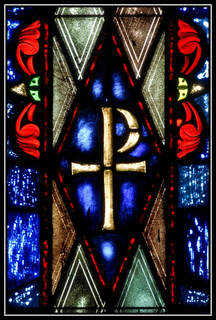-History of the Stained Glass-The stained glass windows of Bethlehem Lutheran Church date back to 1949 when the building which we now occupy was built. Around that time, Bethlehem's congregation had outgrown its facilities at the Lamont Street-Watauga Avenue chapel (which was erected in 1929) and there was a common agreement that a more adequate structure was needed. As early as 1945, under Pastor George Beiderwieden Jr.'s leadership, plans were made for a new church edifice. So strongly did Pastor Beiderwieden feel that a beautiful and lasting cathedral-like church should be built, he staunchly resisted suggestions to the contrary. The building which we now occupy, a church of Old English Gothic design, "A vest pocket cathedral with the warmth of a chapel," as it was so eloquently described by one observer, stands as a monument to the labors of Rev. Beiderwieden, under whom the planning began, Rev. Elmer G. Neunaber, who was pastor when the actual construction started and was completed, the Building Committee, and the congregation, whose sacrifices and faith in the future of Bethlehem Lutheran Church made it possible for us to worship in this lovely structure today. When the church was dedicated in 1950, the dedicatory booklet printed for the occasion contained the following about the Bethlehem's stained glass windows: "...All windows are set in stone to make for greater beauty and performance. In the nave the windows are of leaded art glass, highly decorative, with richly colored slender windows above the altar. All other windows are of antique glass in pleasing shades and set in steel casements...Bethlehem congregation now has an adequate and beautiful plant to carry on its God-given task of reaching, winning, and keeping souls for the Kingdom of God." Not a lot is known of the origin of the windows themselves, but we do know that they were made by an Italian company. Except for a small repair to the Alpha & Omega window, the windows stand today as originally placed in 1949. |
Full Window Gallery
Symbols & Their Meanings
5. Large Window Left of Chancel
This three-paneled window contains a central image surrounded by other symbols. In the center window, the Agnus Dei (Latin for the Lamb of God) symbolizes Christ as the "lamb of God who takes away the sin of the world" (John 1:29). The Lamb is carrying the banner of victory and standing on the Book of the 7 Seals. To the left is the Staurogram. This symbol (⳨) combines two Greek letters, tau (Τ) and rho (Ρ), but the focus is not the letters (because they don't stand for anything), but rather the picture that the combined letters make. Early Christians used the Staurogram to visually represent Jesus on the cross. The closed loop at the top is Jesus' head. The window on the right is a triangle intertwined with a circle representing the Holy Trinity and the eternal nature of God.
6. Altar Windows
These three windows are the focal point of the church. The center window shows a section of the wooden cross and the scroll reads INRI (Latin initials for "Jesus of Nazareth, King of the Jews" , the title that Pontius Pilot had written over the head of Jesus on the cross (John 19:19). The window on the left holds a picture of the chalice with the letters "IHS" on the Holy Eucharist. IHS (ΙΗΣ), which are the letters J-E-S in Greek, is the shortened form of Jesus. Here, IHS symbolizes the real presence of Christ in the Eucharist. The right window shows a phoenix above flames symbolizing resurrection or rebirth. The ancients thought that this mythical bird, instead of dying when old, set fire to its nest and rose rejuvenated from the flames.
7. Large Window Right of Chancel
This is the second window with three panels. In the center window, the anchor cross reminds us that Christ is our anchor and is a symbol of Christian hope. The left window shows a Latin cross with the rising sun behind, sometimes called the cross of glory. The right window depicts what is believed to be an olive branch which symbolizes peace with God and healing from sin won for us by the Lamb.
12. Luther Rose Window
|
The Luther Rose, which was the seal designed by Martin Luther in the 1520s, is the most recognized symbol for Lutheranism. Luther explained that the red heart with the black cross at the center should remind us that the righteous live by faith in Christ the Crucified. The heart rests on a white rose to show that faith gives joy, comfort and peace. The rose is white, not red, because white is the color of heavenly spirits and angels. The white rose stands in a field of blue, the color of heaven, to show that joy in the spirit and in faith in this life is only the beginning of future heavenly joy. Luther Roses may also contain a gold ring around it to show that happiness and joy in heaven has no end but lasts forever, just as gold is the highest, most noble and precious metal.
|























